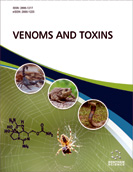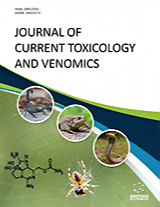Abstract
The venoms of Tunisian wildlife snakes are complex mixtures containing proteins/ peptides and non-protein molecules. Proteins and peptides are the most abundant compounds responsible for the biological effects of venoms. Snake venoms proteins have enzymatic or nonenzymatic activities, which are grouped into different families, including C-type lectin proteins, disintegrins (long, medium and short disintegrins), Kunitz-type serine protease inhibitors, natriuretic- like peptides, vascular endothelial growth factor-related proteins, L-amino acid oxidases, phospholipases A2 and serine proteinases. With technological advancements, the toxic effects of venoms were turned into potential benefits for clinical diagnosis, basic research and development of new research tools and drugs of potential clinical use. Our research team has shown that Macrovipera lebetina and Cerastes cerastes venom components of Tunisian wildlife snakes had great potential for the development of new drugs for the treatment of cancer, angiogenesis disorders or cardiovascular diseases. This review is an overview of snake venom proteins from Macrovipera lebetina and Cerastes cerastes and their biochemical, pharmacological and molecular characterization and their importance as protein resources with therapeutic potential.
Keywords: Cancer, angiogenesis, cardiovascular disease, disintegrin, phospholipase A2, C-type lectin protein, kunitz-type inhibitor, L-amino acid oxidase.
Graphical Abstract
[http://dx.doi.org/10.3390/toxins11100564] [PMID: 31557973]
[http://dx.doi.org/10.1016/j.toxicon.2012.09.009] [PMID: 23010165]
[http://dx.doi.org/10.1517/14712598.2011.621940] [PMID: 21939428]
[http://dx.doi.org/10.1016/j.biocel.2013.06.009] [PMID: 23811033]
[http://dx.doi.org/10.1016/j.aspen.2011.09.002]
[http://dx.doi.org/10.1002/pmic.200402024] [PMID: 16206329]
[http://dx.doi.org/10.1016/S0959-440X(99)00009-3] [PMID: 10508765]
[http://dx.doi.org/10.1016/j.toxicon.2008.11.006] [PMID: 19059426]
[http://dx.doi.org/10.1038/labinvest.3700088] [PMID: 15048137]
[http://dx.doi.org/10.1016/j.matbio.2007.01.001] [PMID: 17300927]
[http://dx.doi.org/10.1016/j.canlet.2009.05.012] [PMID: 19501458]
[http://dx.doi.org/10.1002/jcp.20935] [PMID: 17323383]
[http://dx.doi.org/10.1016/j.toxicon.2014.04.010] [PMID: 24814013]
[http://dx.doi.org/10.1016/S1570-9639(03)00232-2] [PMID: 14499586]
[http://dx.doi.org/10.1096/fj.201600351R] [PMID: 27974593]
[http://dx.doi.org/10.1038/labinvest.3700350] [PMID: 16200076]
[http://dx.doi.org/10.2174/157018010789869325]
[http://dx.doi.org/10.1021/bi015627o] [PMID: 11827548]
[http://dx.doi.org/10.1016/j.ijbiomac.2016.02.008] [PMID: 26853827]
[http://dx.doi.org/10.1051/jbio/2015023] [PMID: 26820829]
[http://dx.doi.org/10.1016/j.matbio.2009.09.009] [PMID: 19808093]
[http://dx.doi.org/10.1016/j.peptides.2008.05.025] [PMID: 18582511]
[http://dx.doi.org/10.1016/j.pep.2009.02.005] [PMID: 19233283]
[http://dx.doi.org/10.1371/journal.pone.0003414] [PMID: 18923708]
[http://dx.doi.org/10.1016/j.toxicon.2009.08.012] [PMID: 19706303]
[http://dx.doi.org/10.1016/j.matbio.2012.11.015] [PMID: 23262217]
[http://dx.doi.org/10.1016/j.mvr.2014.08.006] [PMID: 25173589]
[http://dx.doi.org/10.1007/s10741-014-9442-y] [PMID: 25062653]
[http://dx.doi.org/10.1186/cc10519] [PMID: 22032777]
[PMID: 1352773]
[http://dx.doi.org/10.7150/ijms.8096] [PMID: 24782648]
[http://dx.doi.org/10.1016/0014-5793(96)00774-0] [PMID: 8769304]
[http://dx.doi.org/10.1016/j.toxicon.2010.12.001] [PMID: 21147145]
[http://dx.doi.org/10.1371/journal.pone.0162632] [PMID: 27618302]
[http://dx.doi.org/10.3390/toxins11090524] [PMID: 31510060]
[http://dx.doi.org/10.2174/0929867321666140205140152] [PMID: 24524761]
[http://dx.doi.org/10.21873/anticanres.11152] [PMID: 27793890]
[PMID: 17591353]
[http://dx.doi.org/10.1111/j.1365-2362.2008.01978.x] [PMID: 18717826]
[http://dx.doi.org/10.1111/j.1365-2362.2005.01444.x] [PMID: 15638821]
[http://dx.doi.org/10.1016/j.canlet.2007.02.015] [PMID: 17399891]
[http://dx.doi.org/10.1016/j.ijbiomac.2018.05.230] [PMID: 29870815]
[http://dx.doi.org/10.1074/jbc.C300454200] [PMID: 14600159]
[http://dx.doi.org/10.1006/bbrc.2000.2078] [PMID: 10652214]
[http://dx.doi.org/10.1074/jbc.M202202200] [PMID: 12021274]
[http://dx.doi.org/10.1097/FJC.0000000000000045] [PMID: 24220315]
[http://dx.doi.org/10.1016/j.toxicon.2009.01.003] [PMID: 19708222]
[http://dx.doi.org/10.1038/labinvest.2009.137] [PMID: 20142800]
[http://dx.doi.org/10.1016/j.matbio.2009.03.007] [PMID: 19351557]
[http://dx.doi.org/10.1371/journal.pone.0010124] [PMID: 20405031]
[http://dx.doi.org/10.1016/j.ijbiomac.2016.05.020] [PMID: 27164498]
[http://dx.doi.org/10.1016/j.toxicon.2014.06.020] [PMID: 25009089]
[http://dx.doi.org/10.1016/j.ijbiomac.2015.09.065] [PMID: 26433175]
[http://dx.doi.org/10.1016/0304-4165(94)00216-K] [PMID: 7766651]
[http://dx.doi.org/10.1111/j.1432-1033.1997.00121.x] [PMID: 9249017]
[http://dx.doi.org/10.1016/S0041-0101(96)00020-7] [PMID: 9028015]
[http://dx.doi.org/10.2174/0929867324666170605091546] [PMID: 28578650]
[http://dx.doi.org/10.1002/btpr.1632] [PMID: 22961812]
 7
7 1
1



